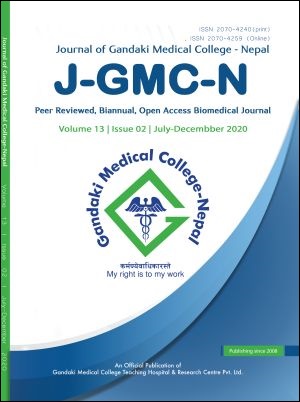Bacteriological profile and antibiotic susceptibility pattern of Neonatal Septicemia in Kanti Children Hospital, Nepal
DOI:
https://doi.org/10.3126/jgmcn.v13i2.29935Keywords:
Antibiotics, microorganism, neonatal sepsis, resistantAbstract
Background: Neonatal sepsis is one of the major causes of neonatal morbidity and mortality globally. Current neonatal mortality rate of Nepal is 21/1000 live birth which is higher than that of the global average of 19.2 and slightly lower than the regional (South East Asia). Pathogenic strains of neonatal sepsis varies from place to place and also from time to time, so it is very important to know the common pathogens and its resistant pattern locally. The aim of this study is to find out the hospital based frequency of neonatal sepsis and characterize the bacteriological profile along with their sensitivity and resistance pattern.
Materials and Methods: This is a retrospective study done in Kanti Children Hospital, Kathmandu, Nepal over the period of one year starting from July 2018 to June 2019.All culture positive cases were enrolled in the study and their sensitivity pattern were analyzed. Results were expressed as percentage, mean, P-Value and Odds Ratio.
Results: A total of 107 cases were culture positive among 1064 probable sepsis accounting 10.05%. Predominant microorganism isolated in this study were staphylococcus aureus 66(61.7%), Klebsiella spp. 15(14%), Esherichia Coli 7(6.5%) followed by Acinatobacter spp 6(5.6%). Most of the Gram positive organisms were resistant to Ampicillin, Cetazidime, Cefotaxime and sensitive to Gentamicin, Amikacin, Imipenam, Vancomycin, Ofloxacin, and Tigecyclin. Whereas Gram negative organisms are resistant to Cephalexin, Ampicillin, Piperacillin/Tazobactum, Cefotaxime and sensitive to Tigecyclin), Vancomycin Chloramphenicol and Colistin.
Conclusion: There was striking similarity in bacteriological profile in both early onset as well as late onset neonatal sepsis. Most of the pathogens were resistant to WHO first line antibiotics Ampicillin and also the resistance is increasing even in 3rd generation Cephalosporin.
Downloads
Downloads
Published
How to Cite
Issue
Section
License
This license allows reusers to distribute, remix, adapt, and build upon the material in any medium or format for noncommercial purposes only, and only so long as attribution is given to the creator.




